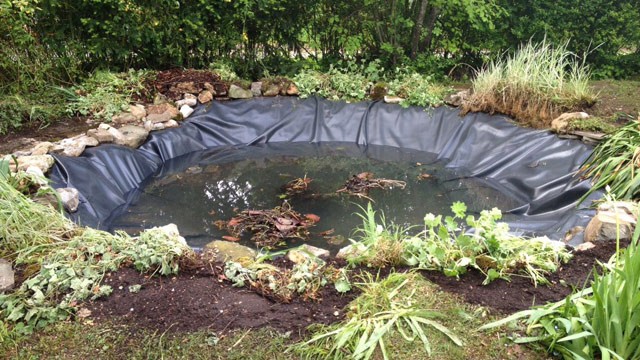Last updated on October 23rd, 2023 at 08:30 pm
What work needs to be done on the garden pond in spring? From the beginning of April, the pond, which has been quiet until then, slowly but surely comes back to life, and with it the fish that have been waiting in a state of winter torpor.
Contents
Garden pond care in spring – explained step by step:
Step 1: Remove leaves
To maintain the water quality of the pond, the water surface should first be cleared of leaves, algae or dead plant parts. The best way to do this is to use a long enough landing net and skim everything off.
Step 2: Cut the marsh plants
The next step is to cut the marsh plants. Sturdy work clothes will help you with this job so that you don’t injure yourself unnecessarily while working. Prune the stems of the marsh plants to just below the water surface.
Some marsh plants, such as reed species, spread quickly and grow enormously in height. Keep this in mind when planting new ponds or, in the case of older garden ponds, be sure to cut back the marsh plants generously and also contain the roots. Otherwise, the pond will increasingly silt up.
Step 3: Refill water, check pond liner for leaks.
If your garden pond has changed its water level over the winter, refill water accordingly now. If the garden pond loses water again in a short time, it has sprung a leak over winter. Locate the spot, most minor cracks can be patched.
Fill the pond with water and wait until the water level stops dropping. At this water level, the leak in the pond liner should usually be located. For repair, you can find the right adhesives and patches, matched to your pond liner, at hardware stores or online retailers.

Step 4: Check and clean the pond pump
The functionality of the pond pump – if any – should be checked. Also, clean the filters or replace them with new ones if necessary. However, do not connect the pump until you can assume that there will be no more frost.
Step 5: Insert plants
Put aquatic plants that have been hibernating in the warm over the winter due to their susceptibility to frost into the pond. Now is also the time to buy new plants and bed them in. Plants for the deeper center of the pond, such as water lilies, are placed in a basket, which you then lower into the desired location.
Step 6: Don’t forget the fish
As described earlier, fish become active in April and thus need food again at regular intervals. So make sure to get food and take care of your fish! Also check if all fish have survived the winter.
In spring, goldfish, for example, are happy to see the sun. In our case, a whole shoal shows up after the winter, they have multiplied. Water plants also provide protection for the fish and also serve as a source of oxygen, such as the water plant.


